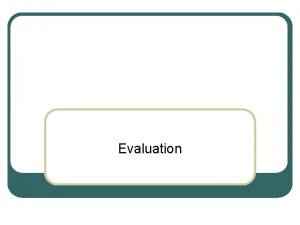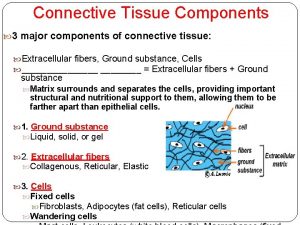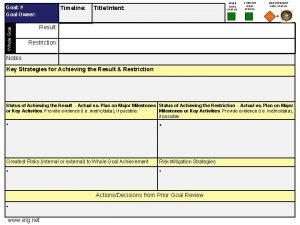Learning Goal Identify the major components of a











- Slides: 11

Learning Goal: Identify the major components of a cell membrane.

Which of the following is NOT a component of the cell membrane? 1. 2. 3. 4. Phospholipids Cholesterol Nucleic acids Proteins

Which letter is pointing to the phospholipid bilayer? 1. 2. 3. 4. J C I F

Which letter is pointing to a protein? 1. 2. 3. 4. C J E I

Which letter is pointing a cholesterol molecule? 1. 2. 3. 4. B D A I

What kinds of molecules are attracted to water? 1. Hydrophobic molecules 2. Hydrophilic molecules

Which part of the phospholipid is hydrophobic? 1. Phosphate heads 2. Fatty acid tails

Water is polar. The inside of the cell membrane is nonpolar. How does water flow through the membrane? 1. 2. 3. 4. Directly across the phospholipid bilayer Through a protein channel Through a cholesterol molecule By attaching to carbohydrate chains

What is the function of channel proteins? 1. changes the fluidity of the cell membrane 2. To make center of the cell membrane hydrophobic 3. Act as an identification marker 4. To provide a pathway for certain substances to cross the cell membrane

What is the function of cholesterol in the cell membrane? 1. 2. 3. 4. To make the center of the membrane hydrophilic To make the center of the membrane hydrophobic To maintain the fluidity of the cell membrane To act as an identification marker for the cell

Blood type is determined by the structure of the cell membrane of red blood cells. What molecule within the cell membrane of red blood cells allows other cells to recognize the red blood cells as type A, B, AB, or O. 1. 2. 3. 4. Phospholipids Cholesterol Protein pumps Carbohydrate chains
 Besra in education
Besra in education A major goal of the counter reformation was to
A major goal of the counter reformation was to The major goal
The major goal Cuadro comparativo de e-learning b-learning y m-learning
Cuadro comparativo de e-learning b-learning y m-learning Identify the major channel alternatives open to a company.
Identify the major channel alternatives open to a company. Retail image
Retail image Straight traffic pattern
Straight traffic pattern Label structure of an egg
Label structure of an egg E commerce business models examples
E commerce business models examples Major structural components of the english spelling system
Major structural components of the english spelling system Mis bidgoli
Mis bidgoli What is information system hardware
What is information system hardware





















